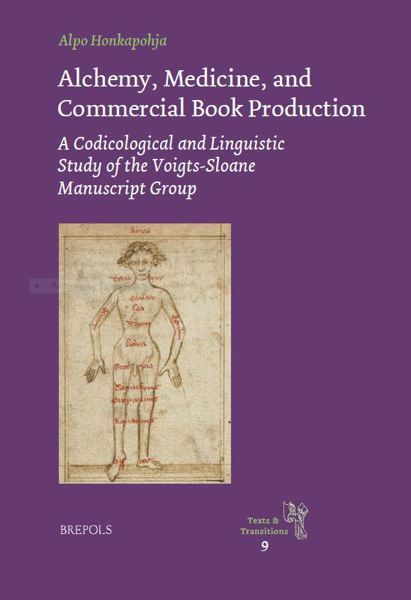
Alchemy, Medicine, and Commercial Book Production
A Codicological and Linguistic Study of the Voigts-Sloane Manuscript Group
Alpo Honkapohja
- Pages: 250 p.
- Size:156 x 234 mm
- Illustrations:57 b/w, 3 col., 20 tables b/w.
- Language(s):English, Latin
- Publication Year:2017
- € 90,00 EXCL. VAT RETAIL PRICE
- ISBN: 978-2-503-56647-4
- Hardback
- Available
- € 90,00 EXCL. VAT RETAIL PRICE
- ISBN: 978-2-503-56935-2
- E-book
- Available
A detailed codicological and historical linguistic analysis of the Voigts-Sloane Group of medical and alchemical manuscripts in the context of commercial production of manuscript books in the decades leading up to the printing press.
“[It] offers a comprehensive analysis of the manuscripts through an ambitious combination of codicological and linguistic approaches. While technical at times, the descriptions are detailed and well structured, making it a pleasant read. Ten years well spent, I would say!” (Flora Guijt, in Parergon, 34/2, 2017, p. 213)
« Il n’y a nul doute à avoir sur l’intérêt et la qualité de ce travail de longue haleine, savamment illustré et bâti avec soin au plus près de mss dont le contenu purement scientifique a été volontairement éludé (…) La belle étude d’A.H. aidera forcément les chercheurs engagés sur cette voie. » (Stanis Perez, dans Le Moyen Âge, 3-4, 2017, p. 625-626)
“This book helps understand the importance of the Sloane mss in depth (...) as a homogeneous ensemble of cultural heritage, providing academics with a rare and precious survey on the production of medical, alchemical, and technical books at the end of the Middle Ages.” (M. del Savio, in Scriptorium Bulletin Codicologique, 1, 2018, p. 48)
“Honkapohja’s research appears to have a solid structure; the exposition is never pedantic: on the contrary, it fascinates the reader as a science fiction book. The presence of illustrations, diagrams and tables allows an immediate and crystal-clear understanding of the subject (…) In the conclusion to the monograph, the reader is left with a rich collection of tools to be used during future climbs; in the last pages, Honkapohja challenges the reader to metaphorically join the expedition and attempt to take the climb further with the benefit of his expertise as a guide, aiming to higher peaks, and conquering a clearer view with each attempt.” (Stefano Daniele, in Nuncius, 33, 2018, p. 639-640)
“There is no doubt that Honkapohja’s book advances our knowledge of text production and dissemination of scientific texts in late medieval England.” (Peter J. Grund, in Speculum, 95/1, 2020, p. 259)
“Tale cautela metodologica anima l’intera monografia, qualificandola come un momento rilevante nello studio delle complesse dinamiche, insieme economiche e culturali, che prepararono la trasformazione del mercato librario nei decenni finali del XV secolo.” (Francesco Berno, in Studi Medievali, LX/II, 2019, p. 1001)
The Voigts-Sloane group of Middle English manuscripts, first described by Professor Emerita Linda Voigts in 1990, has attracted much curiosity and scholarly attention. The manuscripts exhibit a degree of uniformity that may originate from systematic copying of medical and alchemical manuscripts (possibly for speculative sale) in London or its metropolitan area in 1450s and 1460s — only decades before William Caxton established his printing press in Westminster. Some of the manuscripts share a strikingly similar mise-en-page, others present a standard anthology of medical treatises in a standard order.
This book provides a thorough re-examination of these manuscripts through a combination of codicological and linguistic methodologies. It examines different procedures which may have facilitated the production of the manuscripts, including speculative production and copying of separate booklets. The study also addresses the dialect of the manuscripts, and code-switching between Latin and Middle English. By showing that the manuscripts sharing a similar layout are also written in the same dialect, the book thus provides important new information on the dialects of medical writing, and shows that dialect is a further defining feature for this manuscript group. The book also highlights late medieval concerns over alchemy and medicine, explaining the apparent contradiction of the inclusion of alchemy (which was illegal) in commercially copied manuscripts.
This study thus provides both a comprehensive new description of these manuscripts, and sheds new light on the commercial and cultural contexts of book production in late medieval England.
Introduction
Chapter 1. The Book Trade in London before Printing
Chapter 2. Sibling Group: Manuscript Descriptions and Assessing Evidence of Co-ordinated Book Production
Chapter 3. The Core Group: Manuscript Descriptions, Booklet Construction, and Evidence of Origin
Chapter 4. Family Resemblance
Chapter 5. Multilingualism
Chapter 6. Dialect and Dialectology
Bibliography
Index




